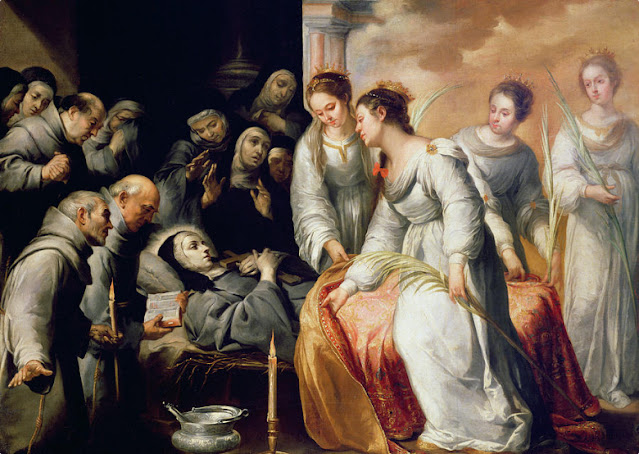Death of St Clare by Murillo
Death of Saint Clare (1646), by Bartolomé Esteban Murillo, portrays the final moments of Saint Clare of Assisi with a profound sense of tenderness and spiritual calm. The scene centers on Clare lying upon her deathbed, her expression serene, as though already turned toward the divine reality she is about to enter. Surrounding her are her sisters of the Poor Clares and attending clergy, their gestures filled with grief, reverence, and prayer. Murillo arranges the figures so that the viewer’s attention is gently guided to Clare’s luminous face, which becomes the quiet heart of the composition.
Two angels appear beside her, dressed in radiant white robes, underscoring the sanctity of the moment. One angel holds a palm branch, a traditional emblem of holiness and spiritual victory, while the other presents a crown, symbolizing Clare’s eternal reward in heaven. These symbols elevate the scene beyond a simple deathbed gathering, revealing it as a moment of triumph, fulfillment, and divine welcome. The warm, soft lighting characteristic of Murillo’s style bathes the figures, giving the atmosphere a gentle glow that suggests the presence of grace.
The artist’s use of warm earth tones, delicate highlights, and carefully observed expressions contributes to the painting’s emotional depth. No dramatic gestures are needed; instead, the silence, reverence, and compassion of the gathered community communicate the profound love and respect held for Saint Clare. Murillo captures not only the sorrow of loss, but also the peace of a soul passing into the joy of eternal life.
The rich color palette, featuring deep shadows and highlights, emphasizes the contrast between the earthly and the divine. Murillo’s detailed rendering of the figures, their expressions, and the textures of their garments gives the painting an emotional depth, while the heavenly elements, including the angels and the ethereal light, elevate the scene to a spiritual plane. This work is a beautiful portrayal of Saint Clare's peaceful transition from life to death, highlighting both the sorrow of those who remain and the glory of her sanctity.
The author, Murillo was a Spanish Baroque painter, well known for his religious works. He began his art studies in Seville under Juan del Castillo, who was his uncle on his mother side. His first works were influenced by Francisco de Zurbaran, Jusepe de Ribera and Alonso Cano, and he shared their strongly realist approach.
As his painting developed, his more important works evolved towards the polished style that suited the bourgeois and aristocratic tastes of the time, demonstrated especially in his Roman Catholic religious works.
In 1642, at the age of 26, he moved to Madrid, where he most likely became familiar with the work of Velazquez. The rich colors and softly modeled forms of his subsequent work suggest these influences.
In that year, he painted eleven canvases for the convent of St. Francisco el Grande in Seville. These works depicting the miracles of Franciscan saints vary between the Zurbaránesque tenebrism of the Ecstasy of St Francis and a softly luminous style (as in Death of St Clare) that became typical of Murillo's mature work.
The characteristic elements of Murillo’s work are already evident: the elegance and beauty of the female figures and the angels, the realism of the still-life details and the fusion of reality with the spiritual world, which is extraordinarily well developed in some of the compositions."
He returned to Seville, where he died in Seville in 1682, a few months after he fell from a scaffold while working on a fresco at the church of the Capuchines in Cadiz.
Esta imagen se encuentra en el dominio público, lo que significa que los derechos de autor de la imagen han expirado o que el titular ha renunciado a sus derechos de autor. Franciscan Gallery cobra por acceder a una copia de alta resolución de esta imagen. La restauración manual es necesaria para mejorar la resolución, sin cubrir o distorsionar la imagen original.






Comments
Post a Comment